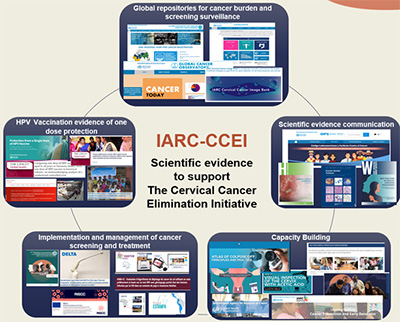Starting date: April 2023
Work Programme
The International Agency for Research on Cancer (IARC) and the World Health Organization (WHO) have complementary functions and mandates to advance cancer control globally. In November 2020, WHO formally launched the Global Strategy to Accelerate the Elimination of Cervical Cancer. IARC is supporting this WHO initiative by providing key evidence, technical materials, and updates for policy-makers, programme managers, and experts implementing the strategy.
The Cervical Cancer Elimination Initiative (CCEI) is supported by three key strategic pillars, with the following targets:
- Vaccination: 90% of girls fully vaccinated with the human papillomavirus (HPV) vaccine by the age of 15 years;
- Screening: 70% of women screened using a high-performance test by the age of 35 years, and again by the age of 45 years;
- Treatment: 90% of women with precancer treated and 90% of women with invasive cancer managed.
Countries should meet the 90–70–90 targets by 2030 to get on the path towards eliminating cervical cancer by the end of this century.
The IARC CCEI Team was formed with the purpose of enhancing communication and coordination with the WHO Cancer Team, as well as facilitating the exchange of knowledge and expertise related to the CCEI.
The primary aim of the IARC CCEI Team is to facilitate communication and coordination among the CCEI partners, including WHO, and to exchange scientific evidence, expertise, and updates about the ongoing relevant IARC initiatives and publications. IARC’s current initiatives and most recent publications to support the CCEI are listed below.
Team Composition
Team Leaders:
Dr Mary Luz Rol (Scientist) and Dr Partha Basu (Branch Head), Early Detection, Prevention, and Infections Branch (EPR), IARC
Emails: RolM@iarc.who.int; BasuP@iarc.who.int
Team members:
Dr Gary Clifford (Deputy Branch Head, EPR)
Dr Iacopo Baussano (Scientist, EPR)
Dr Gabrielle Goldman-Lévy (Pathologist, ESC)
Dr Freddie Bray (Branch Head, CSU)
Dr Ariana Znaor (Scientist, CSU)
Ms Anouk Berger (Branch Head, LCB)
Dr Tatiana Ramirez (Postdoctoral Scientist, EPR)
Key research
40 ongoing research and capacity-building projects to support the CCEI.
Website: https://screening.iarc.fr/cervical_cancer.php
9 projects on HPV vaccination:
- 7 research projects
- 1 training course
- 1 global surveillance project
20 projects on cervical cancer screening:
- 13 research projects
- 1 communication report
- 5 training courses
- 1 global surveillance project
11 projects on cervical cancer treatment:
- 5 research projects
- 1 communication report
- 4 training courses
- 1 global surveillance project
Key publications
HPV vaccination
- Joshi S, Anantharaman D, Muwonge R, Bhatla N, Panicker G, Butt J, et al. (2023). Evaluation of immune response to single dose of quadrivalent HPV vaccine at 10-year post-vaccination. Vaccine. 41(1):236–45. https://doi.org/10.1016/j.vaccine.2022.11.044 PMID:36446654
- Sharma H, Parekh S, Pujari P, Shewale S, Desai S, Bhatla N, et al. (2023). Immunogenicity and safety of a new quadrivalent HPV vaccine in girls and boys aged 9–14 years versus an established quadrivalent HPV vaccine in women aged 15–26 years in India: a randomised, active-controlled, multicentre, phase 2/3 trial. Lancet Oncol. 24(12):1321–33. https://doi.org/10.1016/S1470-2045(23)00480-1 PMID:37949086
- Schuind AE, Rees H, Schiller J, Mugo N, Dull P, Barnabas R, et al. (2023). State-of-the-science of human papillomavirus vaccination in women with human immunodeficiency virus: summary of a scientific workshop. Prev Med Rep. 35:102331. https://doi.org/10.1016/j.pmedr.2023.102331 PMID:37576844
- Man I, Georges D, de Carvalho TM, Ray Saraswati L, Bhandari P, Kataria I, et al. (2022). Evidence-based impact projections of single-dose human papillomavirus vaccination in India: a modelling study. Lancet Oncol. 23(11):1419–29. https://doi.org/10.1016/S1470-2045(22)00543-5 PMID:36174583
- Man I, Georges D, Sankaranarayanan R, Basu P, Baussano I (2023). Building resilient cervical cancer prevention through gender-neutral HPV vaccination. Elife. 12:e85735. https://doi.org/10.7554/eLife.85735 PMID:37486822
Cervical cancer screening and surveillance
- IARC (2022). Cervical cancer screening. IARC Handb Cancer Prev. 18:1–456. Available from: https://publications.iarc.who.int/604
- IARC; Department of Health and Health Service Executive of Ireland (2023). Best practices in cervical screening programmes: audit of cancers, legal and ethical frameworks, communication, and workforce competencies. Lyon, France: International Agency for Research on Cancer (IARC Working Group Reports, No. 11). Available from: https://publications.iarc.who.int/625. Licence: CC BY-NC-ND 3.0 IGO.
- Bouvard V, Wentzensen N, Mackie A, Berkhof J, Brotherton J, Giorgi-Rossi P, et al. (2021). The IARC perspective on cervical cancer screening. N Engl J Med. 385(20):1908–18. https://doi.org/10.1056/NEJMsr2030640 PMID:34758259
- Zhang L, Mosquera I, Lucas E, Rol ML, Carvalho AL, Basu P; CanScreen5 collaborators (2023). CanScreen5, a global repository for breast, cervical and colorectal cancer screening programs. Nat Med. 29(5):1135–45. https://doi.org/10.1038/s41591-023-02315-6 PMID:37106168
- Zhang L, Carvalho AL, Mosquera I, Wen T, Lucas E, Sauvaget C, et al. (2022). An international consensus on the essential and desirable criteria for an ‘organized’ cancer screening programme. BMC Med. 20(1):101. https://doi.org/10.1186/s12916-022-02291-7 PMID:35317783
- Mallafré-Larrosa M, Ritchie D, Papi G, Mosquera I, Mensah K, Lucas E, et al.; CBIG-SCREEN Consortium (2023). Survey of current policies towards widening cervical screening coverage among vulnerable women in 22 European countries. Eur J Public Health. 33(3):502–8. https://doi.org/10.1093/eurpub/ckad055 PMID:37043751
Cervical cancer treatment and surveillance
- WHO Classification of Tumours Editorial Board (2020). Female genital tumours. 5th ed. Lyon, France: International Agency for Research on Cancer (WHO Classification of Tumours series, Vol. 4). Available from: https://publications.iarc.who.int/592.
- IARC and PAHO (2023). Latin America and the Caribbean Code Against Cancer. 1st ed. Lyon, France: International Agency for Research on Cancer; Washington (DC), USA: Pan American Health Organization. Available from: https://cancer-code-lac.iarc.who.int/en/.
- Singh D, Vignat J, Lorenzoni V, Eslahi M, Ginsburg O, Lauby-Secretan B, et al. (2023). Global estimates of incidence and mortality of cervical cancer in 2020: a baseline analysis of the WHO Global Cervical Cancer Elimination Initiative. Lancet Glob Health. 11(2):e197–206. https://doi.org/10.1016/S2214-109X(22)00501-0 PMID:36528031
- Ibrahim Khalil A, Zhang L, Muwonge R, Sauvaget C, Basu P (2023). Efficacy and safety of therapeutic HPV vaccines to treat CIN 2/CIN 3 lesions: a systematic review and meta-analysis of phase II/III clinical trials. BMJ Open. 13(10):e069616. https://doi.org/10.1136/bmjopen-2022-069616 PMID:37879679
- Zhang L, Sauvaget C, Mosquera I, Basu P (2023). Efficacy, acceptability and safety of ablative versus excisional procedure in the treatment of histologically confirmed CIN2/3: a systematic review. BJOG. 130(2):153–61. https://doi.org/10.1111/1471-0528.17251 PMID:35689493

